Decoupling Analysis between Economic Growth and Air Pollution in Key Regions of Air Pollution Control in China
Abstract
1. Introduction
2. Materials and Methods
2.1. Research Areas
2.2. Materials
2.3. Methodology
2.3.1. Conceptual Framework
2.3.2. Tapio Decoupling Model
2.3.3. Classification of Decoupling
2.3.4. Data Preprocessing
3. Results
3.1. Economic Growth
3.1.1. National Level
3.1.2. Key Regions
3.1.3. Typical Provinces
3.2. Analysis of the Decoupling of Economic Growth from SO2 Concentration
3.2.1. Evolution of SO2 Concentration
3.2.2. Decoupling Analysis
3.2.3. Trend Analysis
3.3. Analysis of the Decoupling of Economic Growth from PM10 Concentration
3.3.1. Evolution of PM10 Concentration
3.3.2. Decoupling Analysis
3.3.3. Trend Analysis
3.4. Analysis of the Decoupling of Economic Growth from NO2 Concentration
3.4.1. Evolution of NO2 Concentration
3.4.2. Decoupling Analysis
3.4.3. Trend Analysis
4. Discussion
4.1. Impact of China’s Environmental Policy on the Decoupling between Economic Growth and Air Pollution
4.2. Impact of the Selection of Key Regions on Regional Decoupling
4.3. Analysis of the Causes of Insignificant Improvement of NO2 Decoupling
5. Conclusions and Policy Recommendations
Author Contributions
Funding
Data Availability Statement
Acknowledgments
Conflicts of Interest
References
- Sun, D.Q.; Zhang, J.X.; Hu, Y.; Jiang, J.L.; Zhou, L. Spatial analysis of China’s eco-environmental quality: 1990–2010. J. Geogr. Sci. 2013, 23, 695–709. [Google Scholar] [CrossRef]
- Azam, M. Does environmental degradation shackle economic growth? A panel data investigation on 11 Asian countries. Renew. Sustain. Energy Rev. 2016, 65, 175–182. [Google Scholar] [CrossRef]
- Etokakpan, M.U.; Akadiri, S.S.; Alola, A.A. Natural gas consumption-economic output and environmental sustainability target in China: An N-shaped hypothesis inference. Environ. Sci. Pollut. Res. 2021, 1–13. [Google Scholar] [CrossRef]
- Akadiri, S.S.; Alola, A.A.; Bekun, F.V.; Etokakpan, M.U. Does electricity consumption and globalization increase pollutant emissions? Implications for environmental sustainability target for China. Environ. Sci. Pollut. Res. 2020, 27, 25450–25460. [Google Scholar] [CrossRef] [PubMed]
- Taghizadeh-Hesary, F.; Rasoulinezhad, E.; Yoshino, N.; Chang, Y.; Taghizadeh-Hesary, F.; Morgan, P.J. The energy–pollution–health nexus: A panel data analysis of low- and middle-income Asian countries. Singap. Econ. Rev. 2020, 66, 435–455. [Google Scholar] [CrossRef]
- Taghizadeh-Hesary, F.; Taghizadeh-Hesary, F. The impacts of air pollution on health and economy in Southeast Asia. Energies 2020, 13, 1812. [Google Scholar] [CrossRef]
- Ministry of Ecology and Environment. Report on the State of the Ecology and Environment in China 2019. Available online: http://english.mee.gov.cn/Resources/Reports/ (accessed on 23 September 2020).
- The State Council. The Action Plan for the Prevention and Control of Air Pollution; The State Council: Beijing, China, 2013.
- Feng, Y.Y.; Ning, M.; Lei, Y.; Sun, Y.M.; Liu, W.; Wang, J.N. Defending blue sky in China: Effectiveness of the “Air Pollution Prevention and Control Action Plan” on air quality improvements from 2013 to 2017. J. Environ. Manag. 2019, 252, 109603. [Google Scholar] [CrossRef]
- The State Council. The Three-Year Action Plan to Beat Air Pollution; The State Council: Beijing, China, 2018.
- Hao, D.H.; Li, C.X.; Li, G.Z. Decoupling analysis of economic growth and carbon emissions in Hebei province. Appl. Mech. Mater. 2014, 448, 4520–4523. [Google Scholar] [CrossRef]
- Dong, B.; Zhang, M.; Mu, H.; Su, X. Study on decoupling analysis between energy consumption and economic growth in Liaoning province. Energy Policy 2016, 97, 414–420. [Google Scholar] [CrossRef]
- OECD. Indicators to Measure Decoupling of Environmental Pressure from Economic Growth; OECD: Paris, France, 2002. [Google Scholar]
- Chen, J.; Wang, P.; Cui, L.; Huang, S. Song M. Decomposition and decoupling analysis of CO2 emissions in OECD. Appl. Energy 2018, 231, 937–950. [Google Scholar] [CrossRef]
- Tapio, P. Towards a theory of decoupling: Degrees of decoupling in the EU and the case of road traffic in Finland between 1970 and 2001. Transp. Policy 2005, 12, 137–151. [Google Scholar] [CrossRef]
- Wang, Q.; Jiang, R. Is China’s economic growth decoupled from carbon emissions? J. Clean. Prod. 2019, 225, 1194–1208. [Google Scholar] [CrossRef]
- Cohen, G.; Jalles, J.; Loungani, P.; Marto, R.; Wang, G. Decoupling of emissions and GDP: Evidence from aggregate and provincial Chinese data. Energy Econ. 2019, 77, 105–118. [Google Scholar] [CrossRef]
- Wang, H.; Hashimoto, S.; Yue, Q.; Yue, Q.; Moriguchi, Y.; Lu, Z.W. Decoupling analysis of four selected countries. J. Ind. Ecol. 2013, 17, 618–629. [Google Scholar] [CrossRef]
- Wang, Q.; Zhao, M.; Li, R. Decoupling sectoral economic output from carbon emissions on city level: A comparative study of Beijing and Shanghai, China. J. Clean. Prod. 2019, 209, 126–133. [Google Scholar] [CrossRef]
- Wang, Z.Y. The empirical study on the relationship between energy consumption, carbon emissions and economic growth in Beijing- Tianjin- Hebei. J. Ind. Technol. Econ. 2017, 36, 82–92. [Google Scholar] [CrossRef]
- Yu, Y.D.; Chen, D.J.; Zhu, B.; Hu, S.Y. Eco-efficiency trends in China, 1978–2010: Decoupling environmental pressure from economic growth. Ecol. Indic. 2013, 24, 177–184. [Google Scholar] [CrossRef]
- Lai, W.W.; Hu, Q.L.; Zhou, Q. Decomposition analysis of PM2.5 emissions based on LMDI and Tapio decoupling model: Study of Hunan and Guangdong. Environ. Sci. Pollut. Res. 2021. [Google Scholar] [CrossRef]
- Ji, S.P.; Lv, W.D.; Meng, L.; Yang, X.J.; Yang, H.J.; Chuan, Y.M.; Chen, H.Y.; Tasawar, H.; Ahmed, A.; Bashir, A. Decoupling environmental pressures from economic growth based on emissions monetization: Case in Yunnan, China. J. Clean. Prod. 2019, 208, 1563–1576. [Google Scholar] [CrossRef]
- Wang, Z.; Zhao, L.; Mao, G.Z.; Wu, B. Eco-Efficiency trends and decoupling analysis of environmental pressures in Tianjin, China. Sustainability 2015, 7, 15407–15422. [Google Scholar] [CrossRef]
- Xu, H.F.; Fang, Y.P.; Liu, Y.W. Decoupling analysis of environmental pressure and economic development: A case of the industrial system in Panzhihua. In Proceedings of the IEEE 2011 International Conference on Electronics, Communications and Control (ICECC), Ningbo, China, 1 September 2011. [Google Scholar] [CrossRef]
- Xi, Y.; Yan, D.; Zhang, J.; Fu, X. Decoupling analysis of the industrial growth and environmental pollution in the Circum-Bohai-Sea region in China. Environ. Sci. Pollut. Res. 2021, 28, 19079–19093. [Google Scholar] [CrossRef] [PubMed]
- Wang, Y.; Lai, N.; Mao, G.; Zuo, J.; Crittenden, J.; Jin, Y.; Moreno-Cruz, J. Air pollutant emissions from economic sectors in China: A linkage analysis. Ecol. Indic. 2017, 77, 250–260. [Google Scholar] [CrossRef]
- Zhang, X.; Geng, Y.; Shao, S.; Song, X.; Fan, M.; Yang, L.; Song, J. Decoupling PM2.5 emissions and economic growth in China over 1998–2016: A regional investment perspective. Sci. Total. Environ. 2020, 714, 136841. [Google Scholar] [CrossRef]
- Shi, Y.B.; Zhao, X.X.; Jang, C.L.; Chang, C.P. Decoupling effect between economic development and environmental pollution: A spatial-temporal investigation using 31 provinces in China. Energy Environ. 2019, 30, 755–775. [Google Scholar] [CrossRef]
- Qian, Y.; Cao, H. Decoupling and decomposition analysis of industrial sulfur dioxide emissions from the industrial economy in 30 Chinese provinces. J. Environ. Manag. 2020, 260, 110142. [Google Scholar] [CrossRef] [PubMed]
- Yu, Y.D.; Zhou, L.; Zhou, W.J.; Ren, H.T.; Kharrazi, A.; Ma, T.J.; Zhu, B. Decoupling environmental pressure from economic growth on city level: The case study of Chongqing in China. Ecol. Indic. 2017, 75, 27–35. [Google Scholar] [CrossRef]
- Fang, D.B.; Yu, B.L. Driving mechanism and decoupling effect of PM2.5 emissions: Empirical evidence from China’s industrial sector. Energy Policy 2020, 149, 112017. [Google Scholar] [CrossRef]
- Xia, H.H.; Ding, L.; Yang, S.W.; Wu, A.P. Socioeconomic factors of industrial air pollutants in Zhejiang Province, China: Decoupling and Decomposition analysis. Environ. Sci. Pollut. Res. 2020, 27, 28247–28266. [Google Scholar] [CrossRef]
- National Bureau of Statistics of China. China Statistical Yearbook 2019; China Statistics Press: Beijing, China, 2019.
- Ministry of Housing and Urban-Rural Development. Urban Construction Statistical Yearbook. Available online: http://www.mohurd.gov.cn/xytj/tjzljsxytjgb/jstjnj/ (accessed on 11 April 2021).
- Zheng, B.; Tong, D.; Meng, L.; Liu, F.; Hong, C.P.; Geng, G.N.; Li, H.Y.; Li, X.; Peng, L.Q.; Qi, J.; et al. Trends in China’s anthropogenic emissions since 2010 as the consequence of clean air actions. Atmos. Chem. Phys. 2018, 18, 14095–14111. [Google Scholar] [CrossRef]
- Xinhua News Agency. Beijing: In 2014, the Annual Average Concentration of PM2.5 Decreased by 4.0% Year-on-year, But Dust Pollution Rebounded. Available online: http://www.gov.cn/xinwen/2015-01/04/content_2799777.htm (accessed on 23 September 2020).
- Chen, W.Y.; Xu, R.N. Clean coal technology development in China. Energy Policy 2010, 38, 2123–2130. [Google Scholar] [CrossRef]
- He, K. Multi-resolution Emission Inventory for China (MEIC): Model Framework and 1990–2010 Anthropogenic Emissions. In Proceedings of the AGU Fall Meeting, San Francisco, CA, USA, 3 December 2012. [Google Scholar]
- Fu, M.; Liu, H.; Jin, X.; He, K. National-to port-level inventories of shipping emissions in China. Environ. Res. Lett. 2017, 12, 114024. [Google Scholar] [CrossRef]
- Liu, F.; Beirle, S.; Zhang, Q.; van der A, R.J.; Zheng, B.; Tong, D.; He, K. NOx emission trends over Chinese cities estimated from OMI observations during 2005 to 2015. Atmos. Chem. Phys. 2017, 17, 9261–9275. [Google Scholar] [CrossRef] [PubMed]
- Ding, J.; Van der A, R.J.; Mijling, B.; Jalkane, J.P.; Johansson, L.; Levelt, P.F. Maritime NOx emissions over Chinese Seas derived from satellite observations. Geophys. Res. Lett. 2018, 45, 2031–2037. [Google Scholar] [CrossRef]
- Chai, F. Review and prospect on the atmospheric pollution control in China. Environ. Sustain. Dev. 2020, 3, 5–13. [Google Scholar] [CrossRef]
- Lu, X.; Zhang, S.; Xing, J.; Wang, Y.; Chen, W.; Ding, D.; Wu, Y.; Wang, S.; Duan, L.; Hao, J. Progress of air pollution control in China and its challenges and opportunities in the ecological civilization era. Engineering 2020, 6, 1423–1431. [Google Scholar] [CrossRef]
- Ministry of Ecology and Environment. Beat Air Pollution: China Air Quality Improvement Report (2013–2018); Ministry of Ecology and Environment: Beijing, China, 2019. [Google Scholar]
- Wang, L.; Bi, J.; Meng, X.; Geng, G.; Huang, K.; Li, J.; Tang, L.; Liu, Y. Satellite-based assessment of the long-term efficacy of pm2.5 pollution control policies across the taiwan strait. Remote. Sens. Environ. 2020, 251, 112067. [Google Scholar] [CrossRef]
- Liu, S.J.; Chu, Y.X.; Hu, J.N. Clean air actions and air quality improvements—Beijing-Tianjin-Hebei and surrounding areas, China, 2013−2019. China CDC Wkly. 2020, 2, 418–421. [Google Scholar] [CrossRef]
- The Chinese Academy of Engineering. Final Evaluation Report on the Implementation of the Three-year Action Plan to Beat Air Pollution; The Chinese Academy of Engineering: Beijing, China, 2021. [Google Scholar]
- Zhang, Q.; Zheng, Y.X.; Tong, D.; Shao, M.; Wang, S.X.; Zhang, Y.H.; Xu, X.D.; Wang, J.N.; He, H.; Liu, W.Q.; et al. Drivers of improved PM2.5 air quality in China from 2013 to 2017. Proc. Natl. Acad. Sci. USA 2019, 116, 24463–24469. [Google Scholar] [CrossRef] [PubMed]
- UN Environment. A Review of 20 Years’ Air Pollution Control in Beijing; United Nations Environment Programme: Nairobi, Kenya, 2019. [Google Scholar]
- Wu, Y.; Zhang, S.; Hao, J.; Liu, H.; Wu, X.; Hu, J.; Liu, H.; Walsh, M.P.; Wallington, T.J.; Zhang, K.M.; et al. On-road vehicle emissions and their control in China: A review and outlook. Sci. Technol. 2017, 574, 332–349. [Google Scholar] [CrossRef] [PubMed]
- Chen, Q.S. Analysis of Olympic Economy-empirical analysis based on the Beijing Olympics. China Market 2019, 16, 31–32. [Google Scholar] [CrossRef]
- Xinhua News Agency. In the First Half of 2008, Beijing’s Economic Growth Rate Dropped by 1.1 Percentage Points Year-on-Year. Available online: http://www.gov.cn/jrzg/2008-07/21/content_1051443.htm (accessed on 23 September 2020).
- UN Environment. A Review of Air Pollution Control in Beijing (1998–2013); United Nations Environment Programme: Nairobi, Kenya, 2016. [Google Scholar]
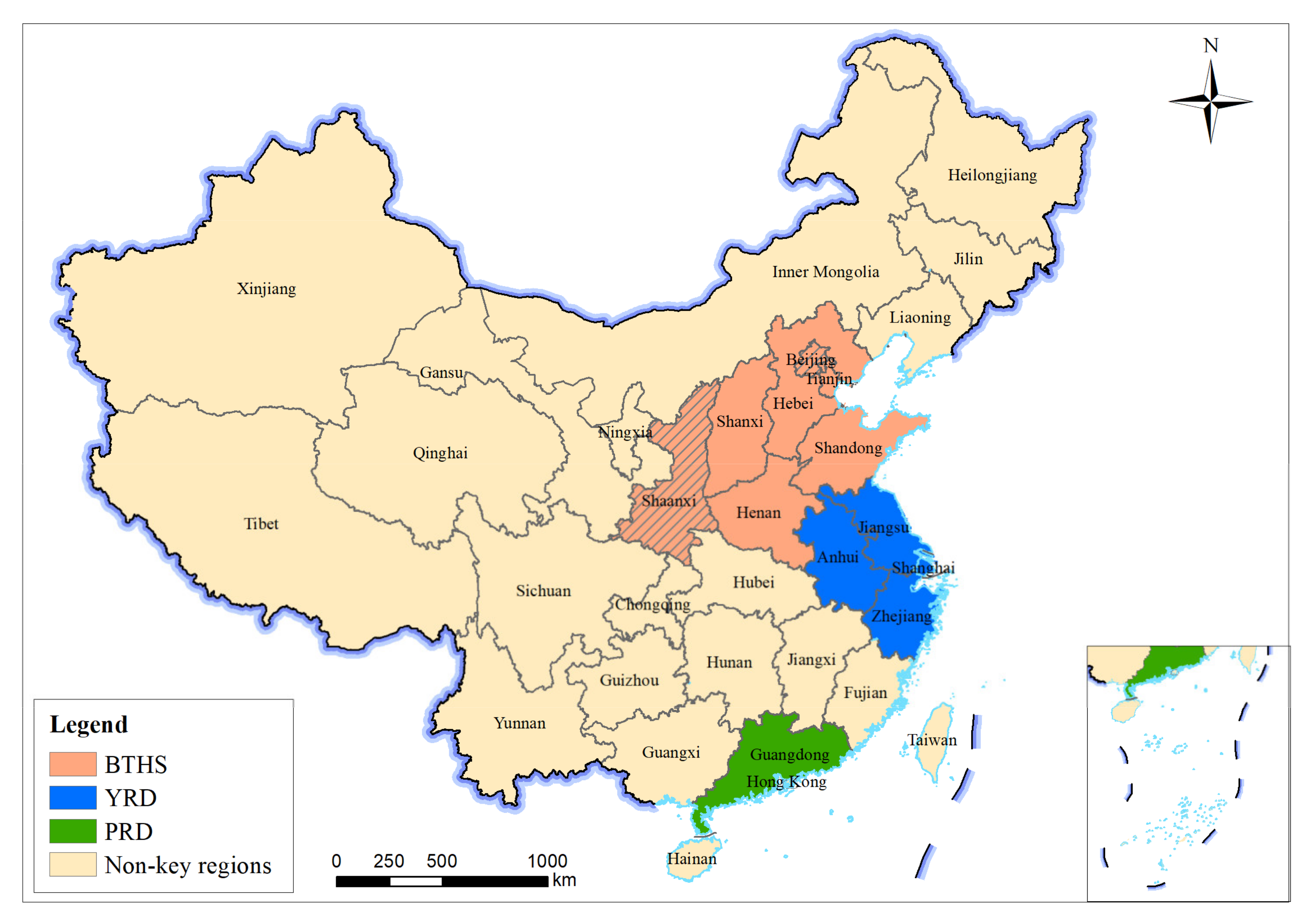
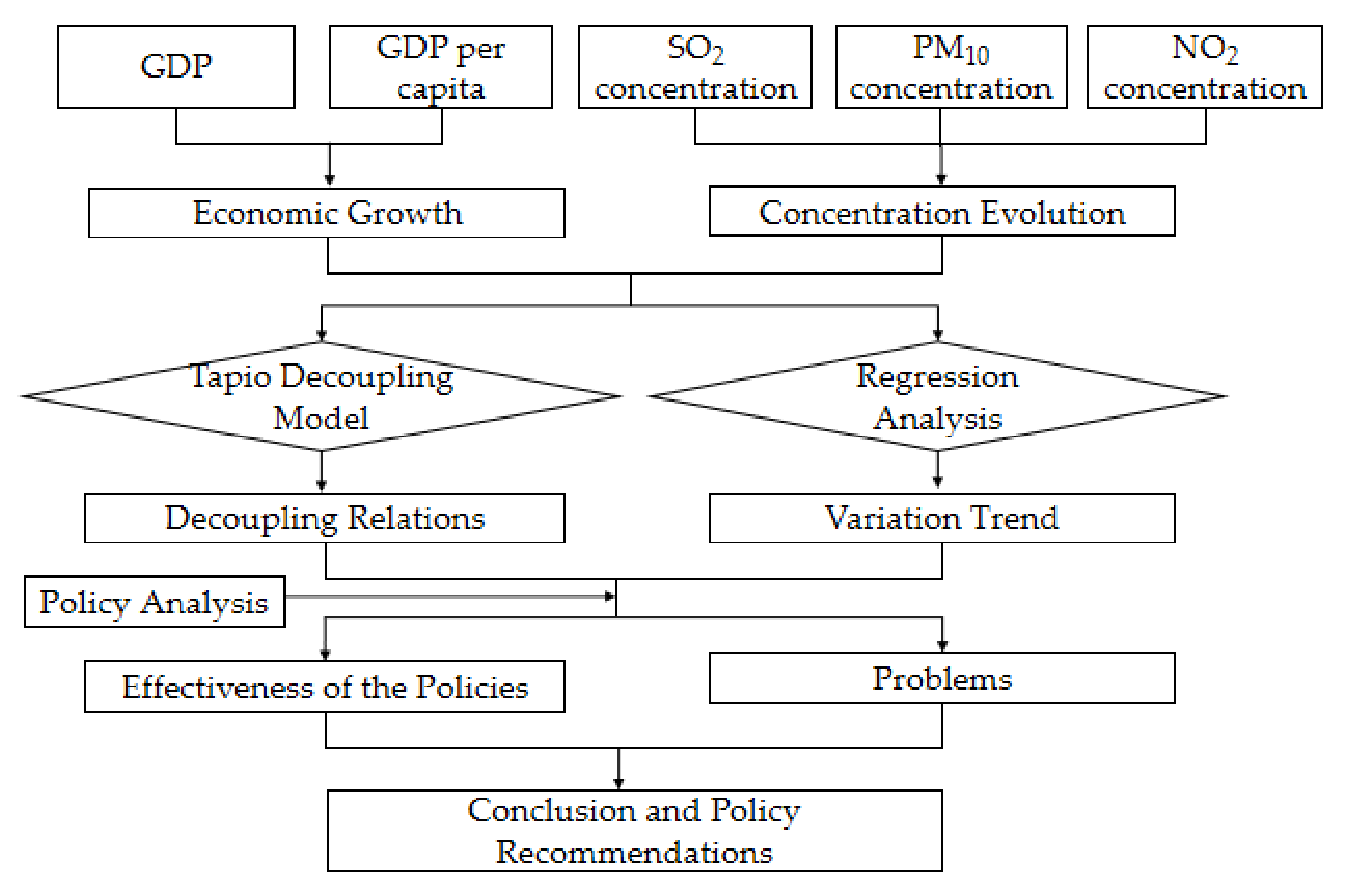

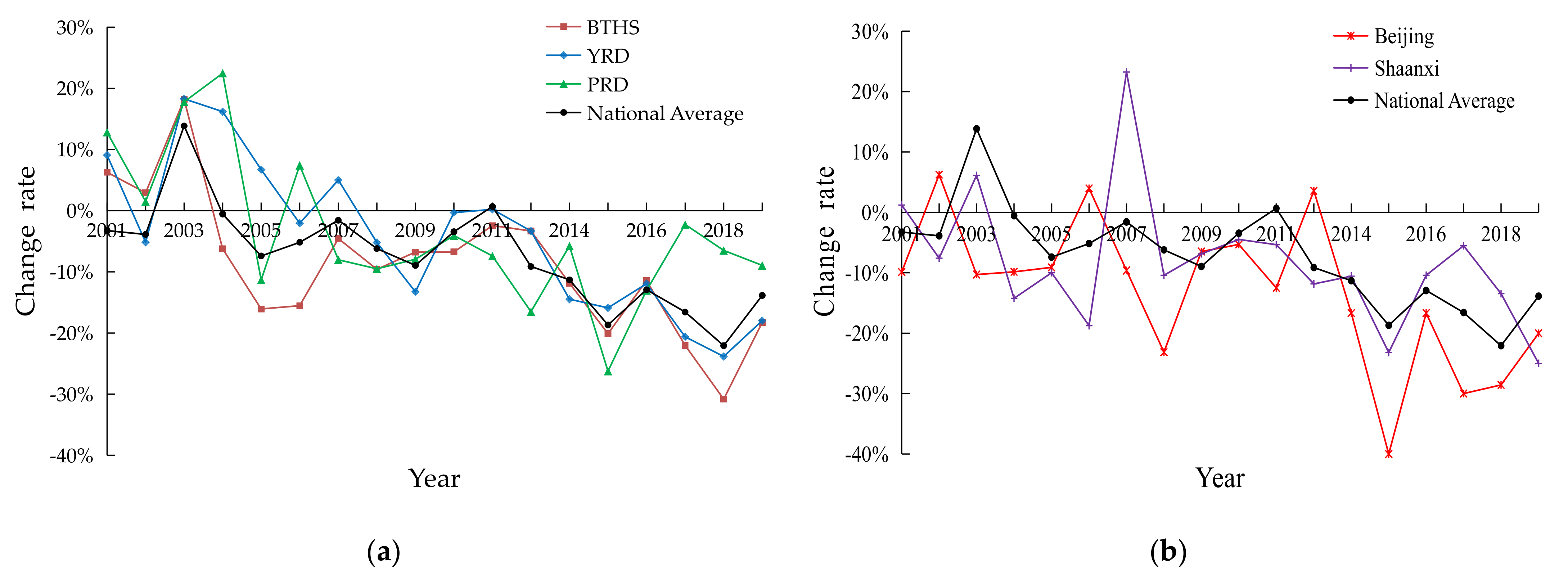
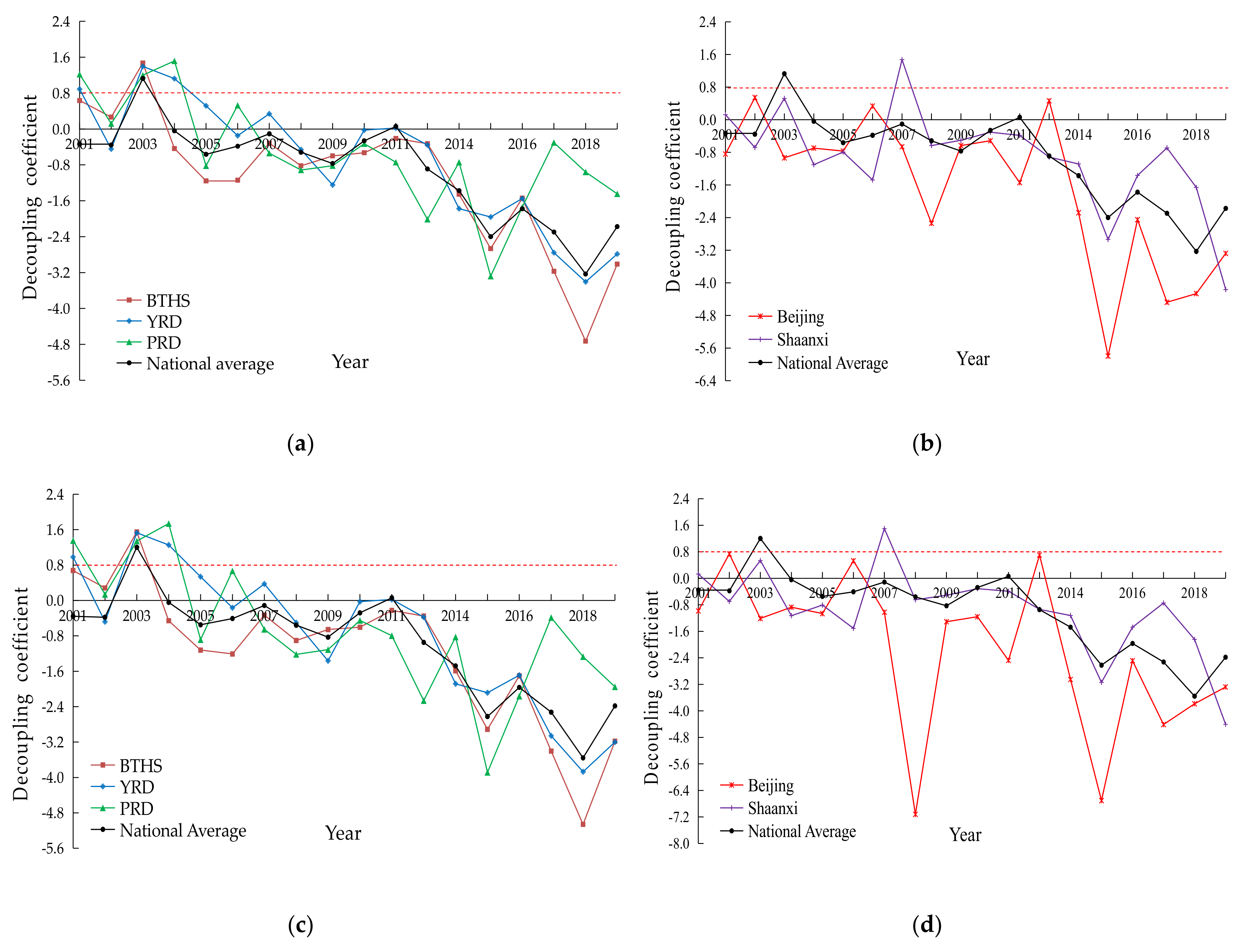
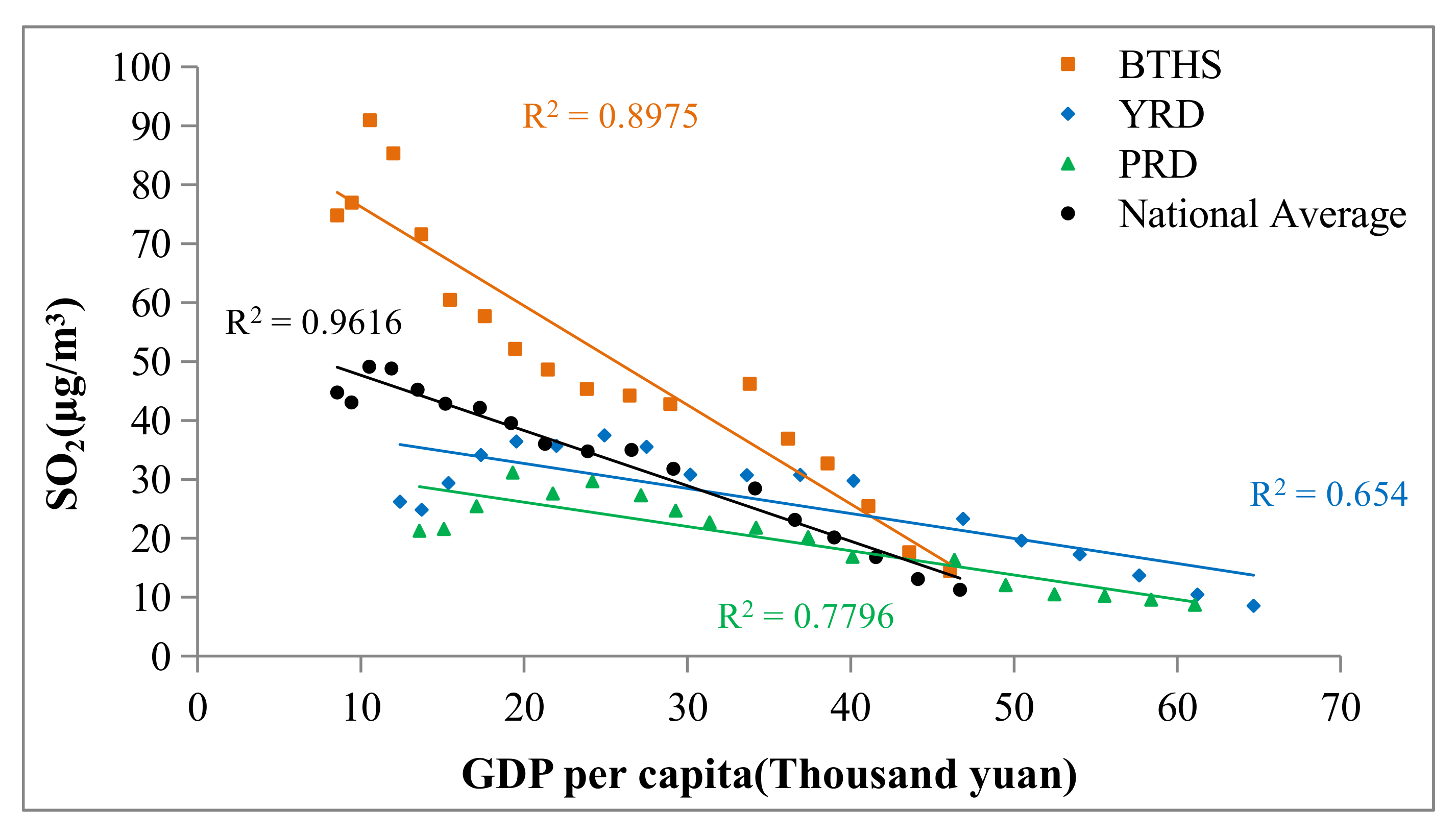
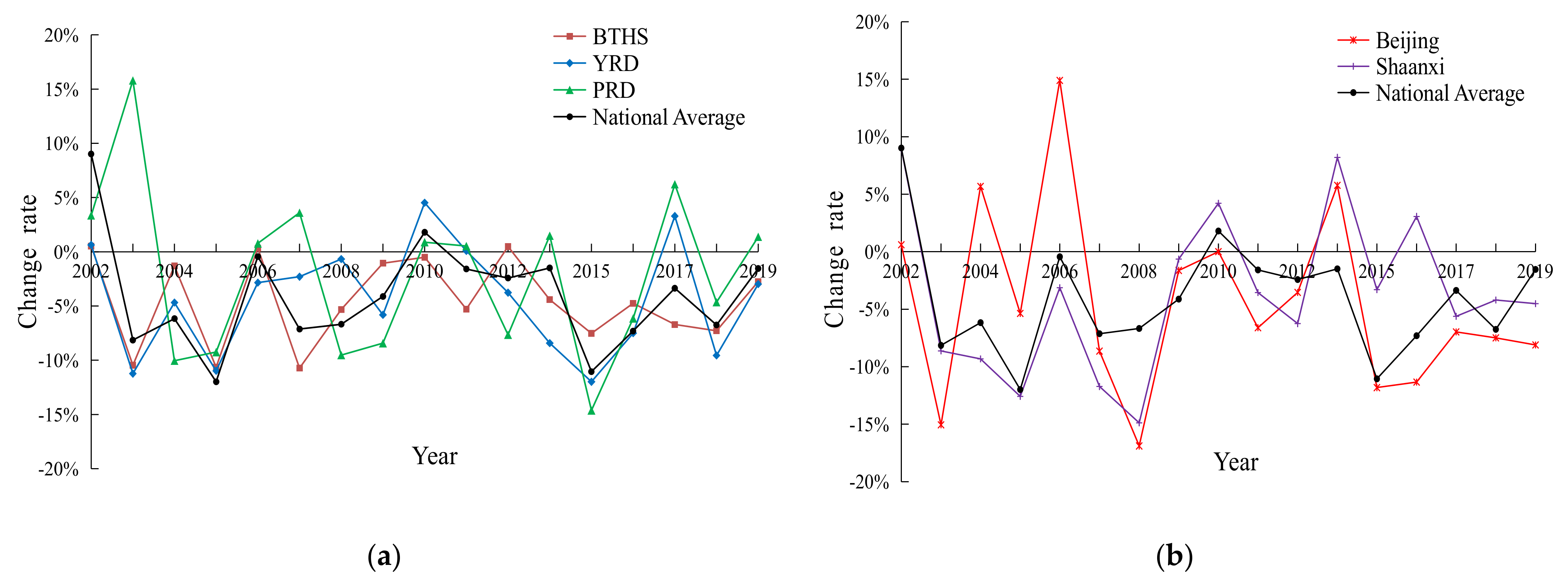

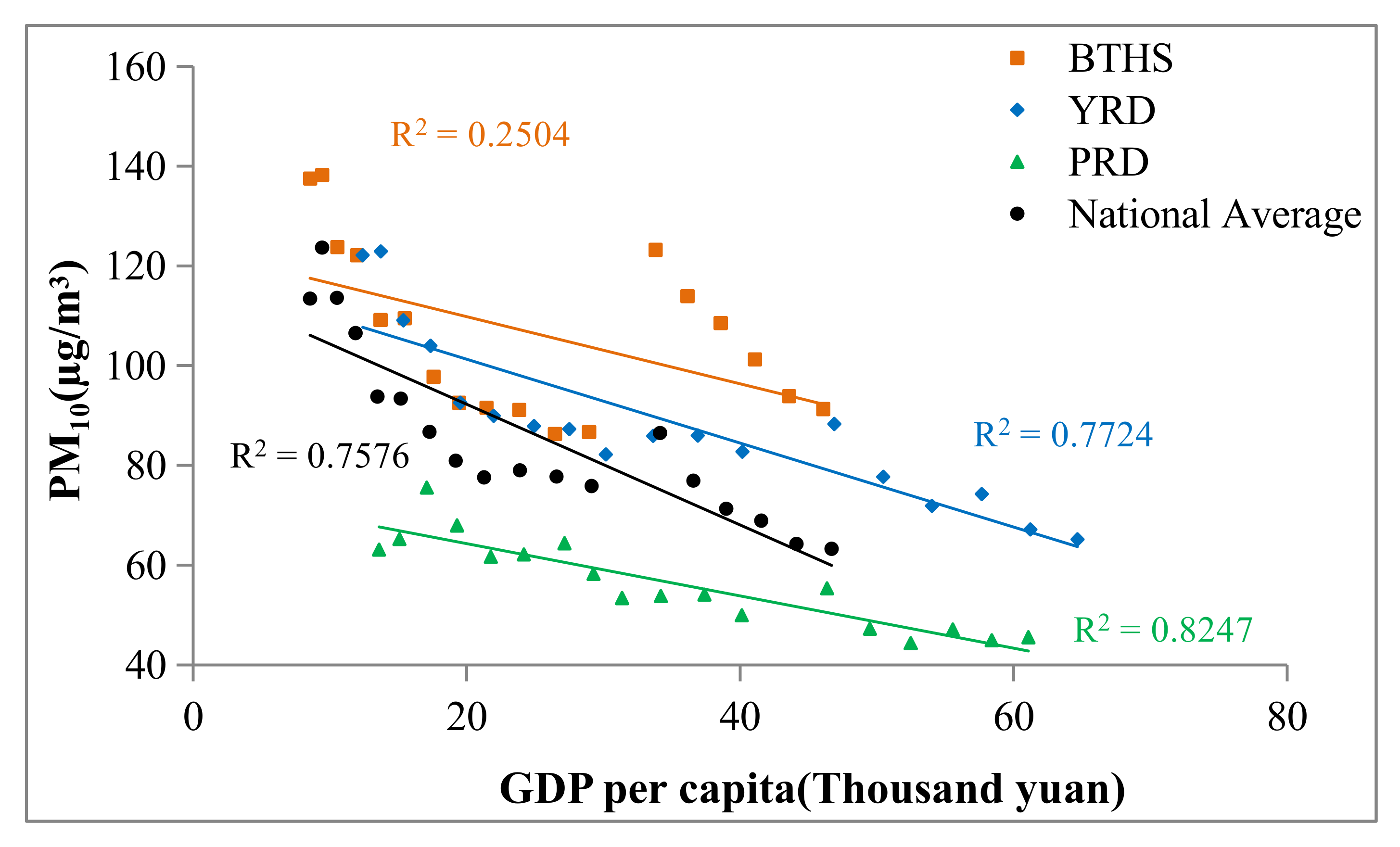
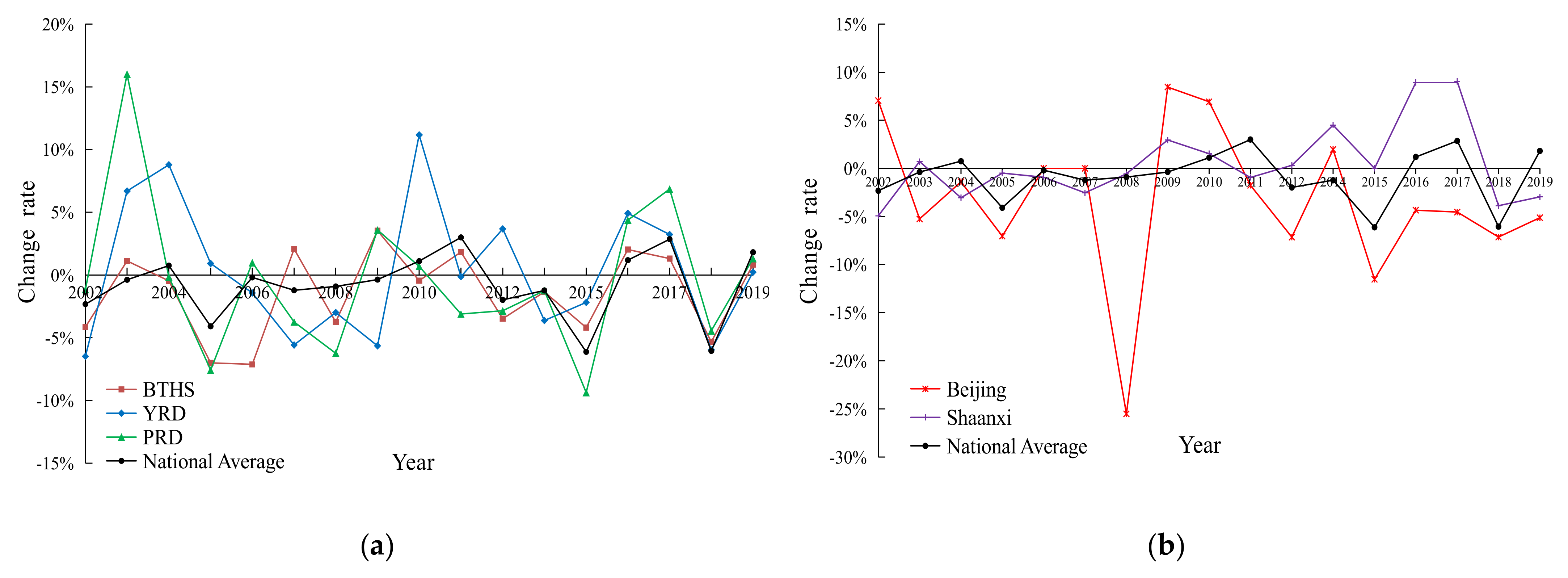


| Parameter | Selected Indicator | Data Source | Indicator Description |
|---|---|---|---|
| Economic growth | GDP | Annual GDP and population figures for 31 provinces, as acquired from the website of the National Bureau of Statistics of the People’s Republic of China | GDP was calculated at a constant price level, using 2000 as the base period, to counteract the effects of inflation |
| GDP per capita | |||
| Environmental pressure (air pollution level) | Annual average concentration of SO2 | Ministry of Ecology and Environment of the People’s Republic of China | Data for 2013 were excluded in this analysis due to changes in monitoring statistical norms |
| Average annual concentration of PM10 | |||
| Average annual concentration of NO2 |
| Quadrant | ΔEt+1 | ΔGt+1 | Decoupling Type | Decoupling Coefficient | Meaning |
|---|---|---|---|---|---|
| IV | <0 | >0 | Strong decoupling | T < 0 | GDP increases and emissions decrease |
| I | >0 | >0 | Weak decoupling | 0 < T ≤ 0.8 | GDP increases and emissions increase |
| Expansive connection | 0.8 < T ≤ 1.2 | GDP increases and emissions increase at the same rate | |||
| Expansive negative decoupling | T > 1.2 | GDP increases and emissions increase more than GDP | |||
| III | <0 | <0 | Recessive decoupling | T > 1.2 | GDP decreases and emissions decrease more than GDP |
| Recessive coupling | 0.8 < T ≤ 1.2 | GDP decreases and emissions decrease at the same rate | |||
| Weak negative decoupling | 0 < T ≤ 0.8 | GDP decreases and emissions decrease less than GDP | |||
| II | >0 | <0 | Strong negative decoupling | T < 0 | GDP decreases and emissions increase |
Publisher’s Note: MDPI stays neutral with regard to jurisdictional claims in published maps and institutional affiliations. |
© 2021 by the authors. Licensee MDPI, Basel, Switzerland. This article is an open access article distributed under the terms and conditions of the Creative Commons Attribution (CC BY) license (https://creativecommons.org/licenses/by/4.0/).
Share and Cite
Li, J.; Hou, L.; Wang, L.; Tang, L. Decoupling Analysis between Economic Growth and Air Pollution in Key Regions of Air Pollution Control in China. Sustainability 2021, 13, 6600. https://doi.org/10.3390/su13126600
Li J, Hou L, Wang L, Tang L. Decoupling Analysis between Economic Growth and Air Pollution in Key Regions of Air Pollution Control in China. Sustainability. 2021; 13(12):6600. https://doi.org/10.3390/su13126600
Chicago/Turabian StyleLi, Jing, Lipeng Hou, Lin Wang, and Lina Tang. 2021. "Decoupling Analysis between Economic Growth and Air Pollution in Key Regions of Air Pollution Control in China" Sustainability 13, no. 12: 6600. https://doi.org/10.3390/su13126600
APA StyleLi, J., Hou, L., Wang, L., & Tang, L. (2021). Decoupling Analysis between Economic Growth and Air Pollution in Key Regions of Air Pollution Control in China. Sustainability, 13(12), 6600. https://doi.org/10.3390/su13126600







